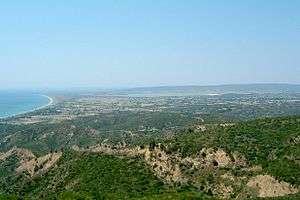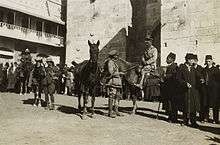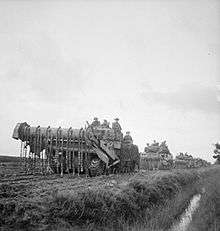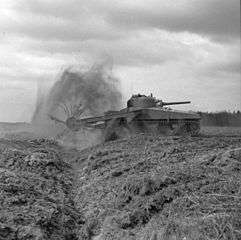Westminster Dragoons
| 2nd County of London Yeomanry Westminster Dragoons | |
|---|---|
.gif) Pre-2006 capbadge of the Westminster Dragoons (other ranks) | |
| Active |
1779–1783 1794–1829 1901–present |
| Country |
|
| Branch |
|
| Type |
Yeomanry (World War I) Royal Armoured Corps (World War II) Army Reserve cavalry |
| Role | Light cavalry |
| Size |
Three Regiments (World War I) One Regiment (World War II) One Squadron |
| Part of | Royal Yeomanry |
| Garrison/HQ | Fulham House, Fulham, London |
| Motto(s) | Fear Naught |
| March | The Westminster Dragoon |
| Mascot(s) | The Gallipolian Cormorant |
| Anniversaries | Jerusalem, Normandy |
| Engagements | Iraq 2003 (as part of the Royal Yeomanry) |
| Commanders | |
| Current commander | Maj C Rotheram |
| Honorary Colonel | Paul Knapman, Deputy Lieutenant of Greater London |
| Insignia | |
| Squadron Stable Belt |
 |
| Regimental Tactical Recognition Flash |
 |
The Westminster Dragoons (WDs) is central London’s only Army Reserve cavalry subunit. One of the Royal Yeomanry's six squadrons, the squadron's current role is light cavalry: to provide a rapidly deployable force with fast mobility and substantial firepower in support of operations. Formed in the aftermath of Second Boer War as part of the County of London Yeomanry, the WDs fought in the Battle of Gallipoli and led British forces onto the beaches during the Normandy Invasion in 1944. The squadron most recently saw action on Operation Telic, when it was mobilised for the 2003 war in Iraq and again in 2006 for peace support operations there. Soldiers and officers of the squadron have also deployed as individual replacements on Operation Herrick in Afghanistan.
History
Formation and early history

The regiment was first recruited from wealthy merchants and bankers as the London and Westminster Light Horse in 1779.[1] It was disbanded in 1783 but in 1793 the Prime Minister, William Pitt the Younger, proposed that the English Counties form a force of Volunteer Yeoman Cavalry that could be called on by the King to defend the country against invasion or by the Lord Lieutenant to subdue any civil disorder within the country.[2] So the regiment was reformed again the following year.[1] The regiment was re-named the Westminster Volunteer Cavalry in 1797[3] and barracks were built to accommodate the regiment in Gray's Inn Road in 1812.[4] The regiment was disbanded again in 1829 and the barracks were decommissioned in 1830.[1]
The Westminster Dragoons was reformed on 24 August 1901 as the 2nd County of London Yeomanry, to meet the need identified during the Second Boer War for a body of trained mounted infantry (see dragoon). Westminster City Council granted them permission to use the name Westminster Dragoons and the use of the city arms as a regimental badge at a meeting on 1 August 1902.[5]
.jpg)
The unit was from the start a smart regiment filled with wealthy gentlemen from the City and the West End. Their attitude and attire was such that, as they strutted across West London, members became known as the 'Piccadilly Peacocks'. The unit's first officers were posted to the WDs from the 1st The Royal Dragoons, one of the forerunners of the Blues and Royals; one of the first troop leaders was the Maharajah Shri Raj Rajeshwar. They brought with them the Royals' then-current capbadge, which was later adopted by Colonels and Brigadiers, which is why, until a common Royal Yeomanry capbadge was adopted in 2006, young WD officers often found themselves amused at being saluted by officers of higher rank. The WD stable belt (worn in barracks) bears the Royal racing colours – the imperial hues of purple, gold and scarlet as a result of the personal friendship of its first commanding officer, Colonel Charles Burn, with King Edward VII.[6]
Even at this time, the WDs were at the forefront of using new equipment, being the second unit in the British army to be equipped with mobile wireless. In 1910, Lord Howard de Walden presented two Marconi pack sets to the Westminster Dragoons, the first sets in the army being those of the Westmorland and Cumberland Yeomanry.[7]
First World War
| London Mounted Brigade |
|---|
|
Organisation on 4 August 1914 |
|
Assigned units
|
|
Training attachments
|
|
In accordance with the Territorial and Reserve Forces Act 1907 (7 Edw. 7, c.9), which brought the Territorial Force into being, the TF was intended to be a home defence force for service during wartime and members could not be compelled to serve outside the country. However, on the outbreak of war on 4 August 1914, many members volunteered for Imperial Service. Therefore, TF units were split in August and September 1914 into 1st Line (liable for overseas service) and 2nd Line (home service for those unable or unwilling to serve overseas) units. Later, a 3rd Line was formed to act as a reserve, providing trained replacements for the 1st and 2nd Line regiments.[8]
1/2nd County of London Yeomanry
In 1914, the regiment consisted of four squadrons and was Headquartered at Elverton Street, Westminster, attached to the London Mounted Brigade for training.[9][lower-alpha 1]

The regiment was posted to Egypt, arriving at Alexandria on 25 September 1914, thereby being one of the first Yeomanry regiments to go overseas on active service. On 19 January 1915, it joined the 1/1st Hertfordshire Yeomanry to form the Yeomanry Mounted Brigade.[12] The brigade joined the 2nd Mounted Division on 13 August and was redesignated as the 5th (Yeomanry) Mounted Brigade. It was dismounted to take part in the Gallipoli Campaign;[13] the regiment left a squadron headquarters and two troops (about 100 officers and men) in Egypt to look after the horses.[14]
The regiment landed at "A" Beach, Suvla Bay on 18 August and moved into reserve positions at Lala Baba on the night of 20 August. On 21 August, it advanced to Chocolate Hill and was in reserve for the attacks on Scimitar Hill and Hill 112.[15] Due to losses during the Battle of Scimitar Hill and wastage during August 1915, the 2nd Mounted Division had to be reorganised. On 4 September 1915, the 1st Composite Mounted Brigade was formed from 1st (1st South Midland), 2nd (2nd South Midland) and 5th (Yeomanry) Mounted Brigades.[16] Each dismounted brigade formed a battalion sized unit, hence the regiment was amalgamated with the Hertfordshire Yeomanry to form 5th Yeomanry Regiment.[17]
5th Yeomanry Regiment left Suvla on 31 October 1915 for Mudros. It left Mudros on 27 November, arrived at Alexandria on 1 December and went to Mena Camp, Cairo.[18] The brigade left the 2nd Mounted Division on 7 December, was reformed and remounted, and joined the Western Frontier Force. The Yeomanry Mounted Brigade was broken up by March 1916, and the regiment was attached to the 6th Mounted Brigade, still in the Western Frontier Force.[9]
The regiment was split up at the beginning of 1917:[9]
- RHQ and C Squadron were on the Northern Section of the Suez Canal Defences
- A Squadron was assigned to the 53rd (Welsh) Division from 14 January to 14 February then with 74th (Yeomanry) Division from 5 April to 23 August
- B Squadron acted as the depot squadron at Zeitoun, Cairo from 17 January to 23 August

In August 1917, the regiment was concentrated and formed XX Corps Cavalry Regiment.[9] It was transferred to Egypt and then to Palestine, where it served in the campaign against the Turks. The WDs were involved in fierce fighting, both mounted and dismounted. As they were the first formed body of troops to enter Jerusalem, they bear the liberation of that city as a battle honour.[19]
In April 1918, the regiment left XX Corps and was reformed as F Battalion, Machine Gun Corps. F Battalion, MGC was posted to France, arriving on 1 June 1918.[9] On 19 August 1918 it was renumbered[20] as 104th (Westminster Dragoons) Battalion, Machine Gun Corps.[21] It remained on the Western Front for the rest of the war. At the Armistice, it was serving as Army Troops with the Second Army.[22]
2/2nd County of London Yeomanry
The 2nd Line regiment was formed at Westminster in August 1914. Early in 1915, it went to Feltham and in the summer to Harlow. There are three versions of its subsequent history:[9]
- Order of Battle of Divisions Part 2A. The Territorial Force Mounted Divisions and the 1st-Line Territorial Force Divisions (42-56) says that the regiment joined the 60th (2/2nd London) Division at Harlow on 24 June 1915, transferred to 61st (2nd South Midland) Division on 24 January 1916[23] until February when the division moved to Wiltshire.[24] On 20 February, it joined 59th (2nd North Midland) Division and was with the division until April.[25] There is no further mention.
- the official Commanders Home Forces shows the regiment with the 58th Division in June 1916. It is then listed as overseas up to April 1918 and in August 1918 as with the Tank Corps.[9]
- the regimental history, 2nd County of London (Westminster Dragoons) Yeomanry: The First Twenty Years says that the regiment went to France, dismounted, at the end of 1915 for guard duties. It then returned to Wool in the summer of 1916. Most of the other ranks were posted to the infantry and the officers and senior NCOs joined the Tank Corps.[9]
There are no battle honours to support overseas service in France.[lower-alpha 2] It appears that the unit was absorbed into the Tank Corps.[9]
3/2nd County of London Yeomanry
The 3rd Line regiment was formed in 1915 and in the summer was affiliated to a Reserve Cavalry Regiment in Eastern Command. In 1916, it was with the 9th Reserve Cavalry Regiment at The Curragh and in early 1917 it was absorbed into the 4th Reserve Cavalry Regiment at Aldershot.[9]
Inter-war
After the first world war, the WDs once again embraced new technology, making the decision to become an armoured car unit at a time when many yeomanry units were determined to remain mounted. In War Office letter 9/Yeomanry/964 dated 5 May 1920 concerning the conversion of all bar the fourteen most senior Yeomanry regiments from cavalry, the Westminster Dragoons are shown as having elected to convert immediately. The decision to accept immediate conversion was that of its then commanding officer, Lord Howard de Walden. On 11 March 1920, the regiment reformed with the title 4th Armoured Car Company (Westminster Dragoons).[26][lower-alpha 3]
It was at this time, as well, that the Regiment formed its link with the Royal Tank Regiment. In 1922, the regiment, now styled 22 (London) Armoured Car Company (Westminster Dragoons) became affiliated to the Tank Corps, which, in turn, was created the Royal Tank Corps on 18 October 1923. The black beret became the official headgear of the Royal Tank Corps in 1926 and was thereafter also adopted by the Westminster Dragoons, which became (and remain to this day) the only other unit in the British Army to wear the black beret.[28] Just before the outbreak of the Second World War in 1939, the Westminster Dragoons became an Officer Cadet Training Unit, with over 90 per cent of pre-war Westminster Dragoons gaining their commissions and transferring into units throughout the British Army before the Regiment reverted to an armoured role in 1940. Among them was Captain Philip John Gardner VC MC, who had joined as a trooper before the war, commissioned and then transferred to the Royal Tank Regiment, going on to win the Victoria Cross for saving the life of a badly wounded officer of the King's Dragoon Guards whose armoured car was out of action and under heavy fire.[29]
Second World War


The Germans planted over four million mines along the French coast to hinder the Allied landings in 1944. To break through these defences at the start of the Normandy Invasion, the British produced a number of novel armoured fighting vehicles under the ingenious direction of Major General Percy Hobart, including the Sherman Crab. The Crab bore a rotating drum with dozens of chains attached; these detonated mines in its path to produce a beaten passage through the thickest of minefields. The Westminster Dragoons were trained in this vital task, as part of 79th Armoured Division, led by Hobart. Along with 81 and 82 Squadrons of 6 Assault Regiment Royal Engineers, B and C Squadrons of the Westminster Dragoons were the first units to land on Gold Beach on D-Day in the British sector[30] clearing paths off the beach and using their tank guns to destroy defences holding up the assault.[31]
Post War
Following the War, the regiment was re-constituted with its headquarters in Westminster.[3] It then amalgamated with R (Berkshire Yeomanry) Battery, 299 (Royal Buckinghamshire Yeomanry, Berkshire Yeomanry, and The Queen's Own Oxfordshire Hussars) Field Regiment RA, to form The Berkshire and Westminster Dragoons in 1961.[3] After the Berkshire Yeomanry was demerged as 94 (Berkshire Yeomanry) Squadron, 71 Signal Regiment, Royal Signals in 1967, the Westminster Dragoons lineage was continued by HQ (Berkshire and Westminster Dragoons) Squadron, The Royal Yeomanry.[3] A bomb which detonated at the regiment's drill hall in Elverton Street caused minor damage in November 1971.[32]
The squadron operated as a medium reconnaissance unit equipped with armoured cars.[33] It continued in this role until 1996, when it became part of the British Army's nuclear, biological and chemical defence regiment.[34] It served in the NBC role until 1999. In that year, the Joint NBC Regiment was formed as a joint regular Army and Royal Air Force unit composed of four squadrons of the 1st Royal Tank Regiment and 27 Squadron Royal Air Force Regiment.[35]
In January 2003, the Westminster Dragoons and A (Royal Wiltshire Yeomanry) Squadron were mobilised (along with augmentees from the Royal Yeomanry's three other squadrons and from the Royal Logistic Corps) for the impending war in Iraq. Together, these mobilised elements became a much-enlarged squadron of the Joint NBC Regiment. Westminster Dragoons found themselves serving with 16 Air Assault Brigade, 7 Armoured Brigade (the Desert Rats) and 3 Commando Brigade as NBC specialists, before switching roles to infantry “peace support” operations once Saddam Hussein’s regime had collapsed.[36] The squadron also provided individual replacements for Operation Herrick in Afghanistan.[37]
Following the Army 2020 review, the squadron’s role became that of light cavalry: providing a rapidly deployable force with fast mobility and substantial firepower as part of the British Army's combat arm. Its soldiers provide reconnaissance, reassurance, security and, if the situation demands it, decisive tactical effects by raiding and attacking the enemy.[38]
Battle honours
The 2nd County of London Yeomanry (Westminster Dragoons) have been awarded the following battle honours:[3]
- Second Boer War
- World War I
Courtrai, France and Flanders 1918, Suvla, Scimitar Hill, Gallipoli 1915, Suez Canal, Egypt 1915–17, Gaza, El Mughar, Jerusalem, Palestine 1917–18
- World War II
Normandy Landing, Villers Bocage, Venraij, Meijel, Venlo Pocket, Roer, North-West Europe 1944–45
- Iraq War
Iraq 2003 (as part of the Royal Yeomanry)
Uniform
Prior to 1914 the Westminister Dragoons wore a scarlet and blue full dress uniform modeled on that of the 1st Royal Dragoons - a regular regiment to which the first commanding officer of the yeomanry unit had belonged. The Westminster Dragoons had the unusual distinction of a purple plume (later replaced by white when the purple dye showed a tendency to run in the rain) on its white-metal helmet, plus purple facings.[39] Overalls (tight fitting cavalry breeches) were dark blue with yellow stripes.[40]
See also
Notes
- ↑ After HQ (Berkshire and Westminster Dragoons) Squadron, The Royal Yeomanry vacated the Elverton Street drill hall in 1980[10] and moved to the Duke of York's Headquarters,[11] it was demolished and replaced by a housing and office complex.[10]
- ↑ Had the 2nd Line served on the Western Front in 1915 and 1916, it would be entitled to the battle honour France and Flanders, 1915–16.
- ↑ The eight yeomanry regiments converted to Armoured Car Companies of the Royal Tank Corps (RTC) were:[27]
- 19th (Lothians and Border) Armoured Car Company, Royal Tank Corps from Lothians and Border Horse
- 20th (Fife and Forfar) Armoured Car Company, Royal Tank Corps from Fife and Forfar Yeomanry
- 21st (Gloucestershire Yeomanry) Armoured Car Company, Royal Tank Corps from Royal Gloucestershire Hussars
- 22nd (London) Armoured Car Company (Westminster Dragoons), Royal Tank Corps from Westminster Dragoons
- 23rd (London) Armoured Car Company, Royal Tank Corps from 3rd County of London Yeomanry (Sharpshooters)
- 24th (Derbyshire Yeomanry) Armoured Car Company, Royal Tank Corps from Derbyshire Yeomanry
- 25th (Northamptonshire Yeomanry) Armoured Car Company, Royal Tank Corps from Northamptonshire Yeomanry
- 26th (East Riding of York Yeomanry) Armoured Car Company, Royal Tank Corps from East Riding Yeomanry
References
- 1 2 3 "Light Horse Volunteers of London and Westminster". Aim 25. Retrieved 22 May 2018.
- ↑ "Worcestershire Yeomanry Cavalry (1794-1994)". Archived from the original on 15 August 2004.
- 1 2 3 4 5 "The Westminster Dragoons (2nd County of London Yeomanry) at regiments.org by T.F.Mills". Archived from the original on 15 July 2007. Retrieved 4 April 2014.
- ↑ "UCL Bloomsbury Project". University College London. Retrieved 22 May 2018.
- ↑ "Westminster City Council". The Times (36836). London. 2 August 1902. p. 4.
- ↑ CCP Wilson and N Huw-Williams, "A History of the Westminster Dragoons 1901-1967", p 21.
- ↑ CCP Wilson and N Huw-Williams, "A History of the Westminster Dragoons 1901-1967", p 43.
- ↑ Rinaldi 2008, p. 35
- 1 2 3 4 5 6 7 8 9 10 James 1978, p. 23
- 1 2 "Stepping Forward" (PDF). p. 415. Retrieved 26 December 2017.
- ↑ "Stepping Forward" (PDF). p. 384. Retrieved 26 December 2017.
- ↑ Becke 1936, p. 15
- ↑ James 1978, p. 35
- ↑ James 1978, p. 34
- ↑ Westlake 1996, p. 267
- ↑ Becke 1936, p. 17
- ↑ Becke 1936, p. 13
- ↑ Becke 1936, p. 14
- ↑ "Sir Edmund Allenby on the Fall of Jerusalem". First World War. 9 December 1917. Retrieved 16 November 2017.
- ↑ Baker, Chris. "The 2nd County of London Yeomanry also known as the Westminster Dragoons". The Long, Long Trail. Retrieved 3 October 2014.
- ↑ BEF GHQ 1918, p. 104
- ↑ BEF GHQ 1918, p. 13
- ↑ Becke 1937, p. 29
- ↑ Becke 1937, p. 35
- ↑ Becke 1937, p. 19
- ↑ CCP Wilson and N Huw-Williams, "A History of the Westminster Dragoons 1901-1967", pp 133-134.
- ↑ "The Royal Tank Regiment at regiments.org by T.F.Mills". Archived from the original on 3 May 2007. Retrieved 9 January 2016.
- ↑ "Black Beret". Royal Tank Regiment Association. Retrieved 16 November 2017.
- ↑ "No. 35448". The London Gazette (Supplement). 6 February 1942. p. 645.
- ↑ CCP Wilson and N Huw-Williams, "A History of the Westminster Dragoons 1901-1967", p 184
- ↑ Westminster Dragoons at d-daytanks.org.uk
- ↑ "IRA groups deny London bombing". Ames, Iowa: Ames Daily Tribune. 1 November 1971. p. 14. Retrieved 27 January 2018.
- ↑ "Royal Yeomanry: History". Ministry of Defence. Retrieved 4 May 2014.
- ↑ "The Royal Yeomanry". National archives. Archived from the original on 13 October 2008. Retrieved 22 October 2017.
- ↑ "Biological and Chemical Weapons". Hansard. 7 March 2000. Retrieved 4 May 2014.
- ↑ "Baghdad blitz will dwarf 1991 onslaught". The Telegraph. 19 March 2003. Retrieved 16 November 2017.
- ↑ "Freedom of the Borough for Royal Yeomanry". The Cowan Report. Retrieved 4 May 2014.
- ↑ "Royal Yeomanry". Ministry of Defence. 9 May 2017. Retrieved 16 November 2017.
- ↑ Smith, R.J. The Yeomanry Force at the 1911 Coronation. p. 19. ISBN 0-948251-26-3.
- ↑ R.G. Harris, plate 14 "50 Years of Yeomanry Uniforms", Frederick Muller Ltd., London 1972, SBN 584 10937 7
Bibliography
- Becke, Major A.F. (1936). Order of Battle of Divisions Part 2A. The Territorial Force Mounted Divisions and the 1st-Line Territorial Force Divisions (42-56). London: His Majesty's Stationery Office. ISBN 1-871167-12-4.
- Becke, Major A.F. (1937). Order of Battle of Divisions Part 2B. The 2nd-Line Territorial Force Divisions (57th–69th) with The Home-Service Divisions (71st–73rd) and 74th and 75th Divisions. London: His Majesty's Stationery Office. ISBN 1-871167-00-0.
- Huw-Williams, Captain N. (1987). A Short History of the Westminster Dragoons 1901-1967 (pdf). Westminster: Westminster Dragoons.
- James, Brigadier E.A. (1978). British Regiments 1914–18. London: Samson Books Limited. ISBN 0-906304-03-2.
- Lawson, Captain C.C.P.; Huw-Williams, Captain N. (1969). Huw-Williams, Captain N., ed. A History of the Westminster Dragoons 1901-1967. London. ASIN B003PB00YM.
- Mileham, Patrick (1994). The Yeomanry Regiments; 200 Years of Tradition. Edinburgh: Canongate Academic. ISBN 1-898410-36-4.
- Rinaldi, Richard A (2008). Order of Battle of the British Army 1914. Ravi Rikhye. ISBN 978-0-97760728-0.
- Westlake, Ray (1996). British Regiments at Gallipoli. Barnsley: Leo Cooper. ISBN 0-85052-511-X.
- Order of Battle of the British Armies in France, November 11th, 1918. France: General Staff, GHQ. 1918.
External links
- Baker, Chris. "The 2nd County of London Yeomanry". The Long, Long Trail. Retrieved 6 April 2015.
- The Westminster Dragoons (2nd County of London Yeomanry) at regiments.org by T.F.Mills at the Wayback Machine (archived 15 July 2007)
- "2 County of London Yeomanry (Westminster Dragoons)". Orders of Battle.com.
- HQ (Westminster Dragoons) Squadron Royal Yeomanry official website
- The Westminster Dragoons' unofficial website
- A Westminster Dragoon's diary of Operation Telic
- From the Thames to the Tigris – the Westminster Dragoons in Iraq